
Monardella is a genus of approximately 40 species of annual and perennial plants native to western North America from British Columbia to northwestern Mexico. They are grown for their highly aromatic foliage, which in some species is used for herbal teas. The two-lipped, tubular flowers are formed in terminal clusters and are most usually red, pink, or purple.
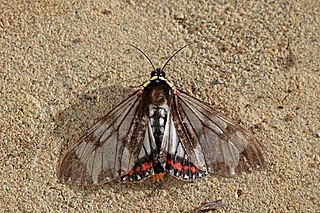
Dysschema is a genus of tiger moths in the family Erebidae. The genus was erected by Jacob Hübner in 1818. The genus contains some of the more showy moths of the southwestern United States.

The Huachuca Mountains are part of the Sierra Vista Ranger District of the Coronado National Forest in Cochise County in southeastern Arizona, approximately 70 miles (110 km) south-southeast of Tucson and southwest of the city of Sierra Vista. Included in this area is the highest peak in the Huachucas, Miller Peak, and the region of the Huachucas known as Canelo Hills in eastern Santa Cruz County. The mountains range in elevation from 3,934 feet (1,199 m) at the base to 9,466 feet (2,885 m) at the top of Miller Peak. The second highest peak in this range is Carr Peak, elevation 9,200 feet (2,804 m). The Huachuca Mountain area is managed principally by the United States Forest Service (41%) and the U.S. Army (20%), with much of the rest being private land (32%). Sierra Vista is the main population center.
Stiria is a genus of moths of the family Noctuidae. The genus was erected by Augustus Radcliffe Grote in 1874.
Sympistis arizonensis is a moth of the family Noctuidae first described by William Barnes in 1928. It is found in the United States in southeastern Arizona as well as northern Colorado. It was formerly known as Oncocnemis arizonensis, but was transferred to the genus Sympistis in 2008.

Lithophane leeae is a moth of the family Noctuidae. It is only found in the Chiricahua Mountains in southeastern Arizona.
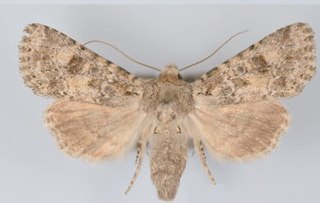
Aseptis catalina is a moth of the family Noctuidae first described by John Bernhardt Smith in 1899. It is found in the deserts of Arizona, California and Baja California in Mexico.
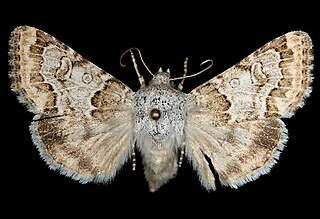
Schinia deserticola is a moth of the family Noctuidae. It is found from southern California to southeastern Arizona and north to west central Utah and southeastern Oregon.
Leuculodes lacteolaria is a moth of the Doidae family. It is found in neotropical Central America, north to Arizona.
Idia parvulalis is a species of litter moth of the family Erebidae first described by William Barnes and James Halliday McDunnough in 1911. It is found in North America, including its type location, the Santa Catalina Mountains in south-eastern Arizona.
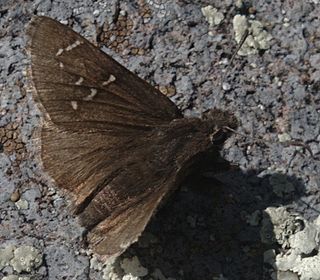
Thorybes mexicana, the Mexican cloudywing, mountain cloudy wing or Nevada cloudy wing, is a butterfly of the family Hesperiidae. It is found in the high elevation mountains of the western United States south into Mexico.
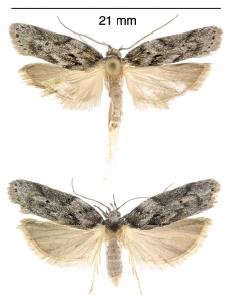
Antaeotricha arizonensis is a moth of the family Depressariidae. It is found in the United States in the mountain ranges in south-eastern Arizona and south-western New Mexico. Although Antaeotricha arizonensis are easily differentiated within their genus through the dark spots on their forewings, the distinction between sexes of A. arizonensis can be complicated. The sexes of A. arizonensis (male&female) differentiate between themselves by distinct characteristics on their antennas and anatomy of their genitalia(Ferris, 59)
Lintneria smithi is a species of moth in the family Sphingidae, the sphinx moths and hawk moths. It is known by the common name Smith's sphinx. It is known from southern Arizona, southeastern New Mexico, and Sonora in northwestern Mexico.
Caudellia nigrella is a species of snout moth in the genus Caudellia. It was described by George Duryea Hulst in 1890. It is found in California and Arizona.
Callophrys fotis is a species of butterfly in the family Lycaenidae, the gossamer-winged butterflies. It is known by several common names, including early elfin, desert elfin, Fotis hairstreak, Strecker's elfin, and Arizona gray elfin. It is native to the southwestern United States, where it occurs in southeastern California, Nevada, Utah, western Colorado, northern Arizona, and northwestern New Mexico.
Eupithecia biedermanata is a moth in the family Geometridae first described by Samuel E. Cassino and Louis W. Swett in 1922. It is found in the US state of Arizona.
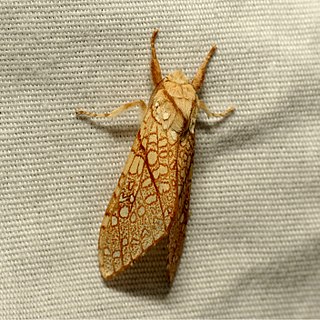
Lophocampa mixta is a moth of the family Erebidae. It was described by Berthold Neumoegen in 1882. It is found in the United States in Arizona, Texas

Pygoctenucha terminalis, the blue-green lichen moth, is a moth in the family Erebidae. It was described by Francis Walker in 1854. It is found in Mexico and in the United States in eastern Colorado, New Mexico and southeastern Arizona.

Pyrausta onythesalis is a moth in the family Crambidae. It was described by Francis Walker in 1859. It is found in North America, where it has been recorded from Florida to Georgia, Iowa, Kansas, Oklahoma, Texas and Arizona.
James Bruce Walsh is an American geneticist whose research focuses on evolutionary and quantitative genetics. He has been Professor of Ecology and Evolutionary Biology at the University of Arizona since 1986. He discovered the moth species Lithophane leeae in 2009, and another moth species, Drasteria walshi, is named after him.









